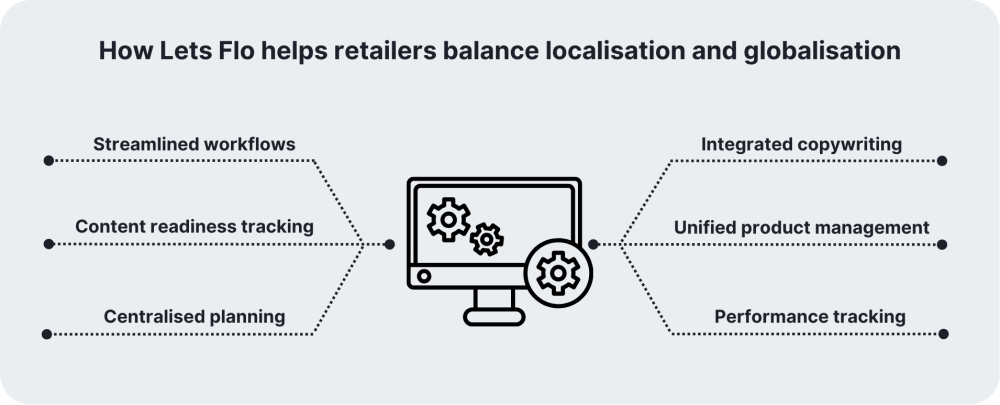Let’s talk about a dilemma that most retailers know all too well. You’ve got a global brand to build, but your customers—from New York to Tokyo—expect content that speaks their language, both literally and culturally. Here’s a stat to put things in perspective: localised content can boost conversion rates by up to 70%. Impressive, right? But pulling that off across multiple markets without losing your brand’s voice is no easy task.
On one side, you’ve got the efficiency of a uniform global strategy—think consistent messaging, simplified workflows, and lower costs. On the other, there’s the undeniable power of localisation—personalised content that resonates with local audiences but can quickly turn into a logistical nightmare to manage. This is where things get tricky.
So, how do you choose? Or better yet, do you even have to?
In this blog, we’re breaking down how to find that balance—so you can stop choosing between scaling fast and staying relevant.
Understanding content localisation vs. globalisation
What is content localisation?
Localisation is all about tailoring your content to fit the local market—language, cultural references, and more. It’s making your brand feel at home wherever it lands.
For example: A fashion retailer entering Japan might swap Western models for local ones, and highlight products that match local trends. The payoff? Content that feels personal and drives higher engagement but it can require significant resources and coordination.
What is content globalisation?
Globalisation, on the other hand, is about creating content that works across markets with minimal changes. It’s the consistency play—same brand message, same visuals, everywhere.
For example, a skincare brand might run a global campaign centred around “self-care,” keeping the messaging and visuals consistent while only adjusting currencies or adding subtitles. It’s easier to manage and scale but risks missing the mark on local relevance.
The pros and cons of localisation for retailers
Advantages:
-
- Increased customer engagement
Content that speaks the local language—both literally and culturally—keeps customers around longer. Tailored product descriptions, regional slang, and localised promotions make your audience feel understood, boosting engagement. - Improved SEO and discoverability
Localisation can give your SEO a serious lift. Using local keywords and languages means your content ranks higher in regional search results, putting your products in front of more eyes—without breaking the bank on ads. - Higher conversion rates
Culturally relevant messaging makes it easier for customers to trust your brand and hit the “Buy Now” button. From familiar payment options to region-specific campaigns, localisation helps close the deal.
- Increased customer engagement
Challenges:
-
- Cost and complexity
Localisation isn’t cheap. Between hiring translators and managing multiple content versions, the costs can add up quickly. For many retailers, it’s about making sure the investment is worth it. - Operational overheads
Coordinating with local teams and managing translations can get complicated fast. The more markets you enter, the harder it is to keep everything consistent and organised.
- Cost and complexity
The pros and cons of globalisation for retailers
Advantages:
-
- Cost-effectiveness
Uniform content means you can scale faster and cut costs by avoiding the need for endless versions. It’s like buying in bulk—the more you standardise, the more you save. - Brand consistency
Globalisation makes it easier to keep your brand voice and messaging unified, no matter where your customers are. This consistency helps build trust and makes your brand instantly recognisable. - Faster market entry
With a one-size-fits-all approach, launching in new markets becomes a lot simpler. You can roll out campaigns quickly without getting bogged down in local adaptations.
- Cost-effectiveness
Challenges:
-
- Cultural disconnect
The biggest downside? Coming off as out of touch. Uniform content might save time, but it can also miss the mark if it doesn’t resonate with local audiences. - Limited personalisation
A standardised approach often means giving up the chance to make customers feel seen and understood. Less personalisation can lead to lower engagement and, ultimately, fewer conversions.
- Cultural disconnect
Finding the right balance: A hybrid approach
Turns out, a hybrid approach might be the way forward. One that lets you scale globally without sacrificing the local flavor that makes your content stick.
- Leverage global themes with local adaptations: Start with core global messaging and add local tweaks like copy and imagery. This way, you get the efficiency of a global strategy without losing local relevance.
- Data-driven decision-making: Use analytics to see which markets need localised content and which can stick to global messaging. Focus your resources where they’ll have the most impact.
- Modular content creation: Create adaptable content blocks—like templates for product descriptions—that can be quickly customised for different markets. It’s faster and keeps your brand voice consistent.
- Optimise where possible: Choose solutions that can handle translations and content distribution efficiently. This frees up your team to focus on strategy instead of logistics.
The goal is to balance global consistency with local relevance—without overloading your team.
How Lets Flo helps retailers balance localisation and globalisation
- Streamlined workflows
Streamlined approvals and content distribution using integrated workflows free your team to focus on strategy instead of admin tasks.
- Integrated copywriting
Lets Flo’s AI copywriting feature effortlessly translates and adapts content for local audiences in over 30 languages. - Content readiness tracking
Lets Flo offers content readiness tracking that helps manage imagery, copy, and other assets efficiently. - Unified product management
Lets Flo’s centralised product information helps teams create content quickly and consistently for both global and local markets.
- Centralised planning
Integrated calendars sync key dates for shoots and campaigns across markets, ensuring that content launches at the right time. - Performance tracking
Detailed analytics on cost, resource utilisation, and team performance help you refine both localised and global strategies based on real-time data.
Lets Flo makes it easy for retailers to manage local and global content efficiently—no trade-offs, just smarter workflows.
See Lets Flo in action today.
Book a demo






